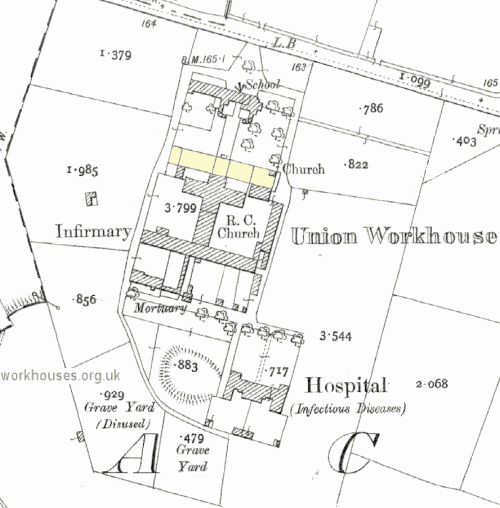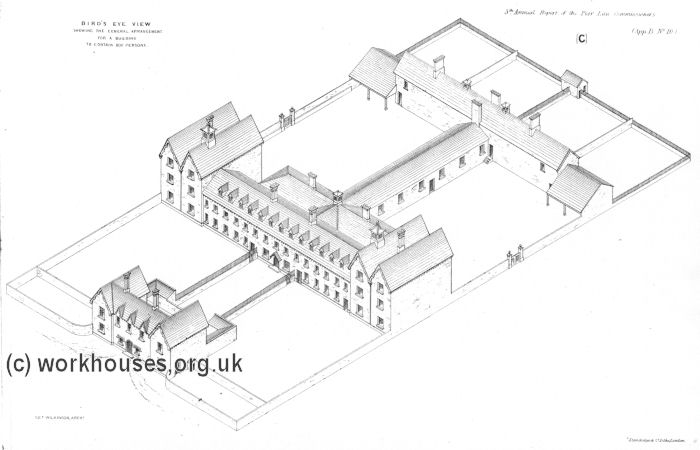County Home, Longford, Co. Longford, Republic of Ireland
The Longford County Home had its roots in the Longford Union Workhouse, erected in 1840-42 on a seven-acre site on Dublin Road, at the east of Longford. Like almost all Irish workhouses, the original buildings were designed by George Wilkinson. There was a small entrance block, nearest to the road. The main accommodation block had the Master and Matron's's quarters at the centre, with male and female wings to each side. A single-storey range containing the kitchen and laundry then linked via the dining-hall and chapel to the infirmary and 'idiots wards' at the rear of the complex. The buildings were intended to accommodate up to 1,000 inmates. During the famine era, a fever hospital was erected at the north of the site.
The Longford workhouse site is shown on the 1914 map below. The position of the main building, destroyed by a fire in 1909, is shown in yellow.

Longford workhouse site, Longford, c.1914.

George Wilkinson's model Irish workhouse design. © Peter Higginbotham
From 1877, the Sisters of Mercy provided the nursing staff in the workhouse infirmary.
Following the creation of the Irish Free State in 1921, the Boards of Guardians that had administered each union area were abolished and the government appointed commissioners to overhaul the existing poor relief system and formulate a county-based plan for its future administration and operation. Boards of Public Assistance and Boards of Health were formed in each county and the existing workhouse sites allocated to new roles. In most cases, the main building in one of the county's former workhouses was adopted as a County Home, accommodating the elderly poor and infirm, the disabled, and people with various mental conditions, referred to at that time as 'lunatics', 'idiots' and 'imbeciles'. County Homes were frequently also used to house unmarried mothers and their children, and some admitted orphaned or abandoned children. Many former workhouse infirmaries, fever hospitals and other medical facilities were redesignated as County, District, Cottage or Fever Hospitals. The county schemes were formalised by Local Government (Temporary Provisions) Act of 1923. In County Longford, one part of the former Longford workhouse infirmary was used as the County Home, and the other part as the medical section of the County Hospital.
A report on the Longford County Scheme in 1927 noted:
In 1951, the county councils of Meath, Westmeath, Cavan, Longford, and Louth formed a consortium to open a new mother and baby home, which opened at Dunboyne in 1955. The Longford County Home then stopped being used for this purpose.
The County Home and Hospital site subsequently adopted the name St Joseph's Hospital, now known as St Joseph's Care Centre. Only the old fever hospital building now survives as Mount Carmel Hospital.
Records
Note: many repositories impose a closure period of up to 100 years for records identifying individuals. Before travelling a long distance, always check that the records you want to consult will be available.
- Longford County Library, Town Centre, Longford, Co.Longford. Details of holdings relating to the County Home unknown. Workhouse records include Board of Guardians' minute books (1839-1922).
Bibliography
- Nicolson, Jill Mother and Baby Homes: a survey of homes for unmarried mothers (1968, Allen & Unwin)
- Redmond, Paul Jude he Adoption Machine: The Dark History of Ireland's Mother and Baby Homes and the Inside Story of How Tuam 800 Became a Global Scandal
Links
Except where indicated, this page () © Peter Higginbotham. Contents may not be reproduced without permission.


